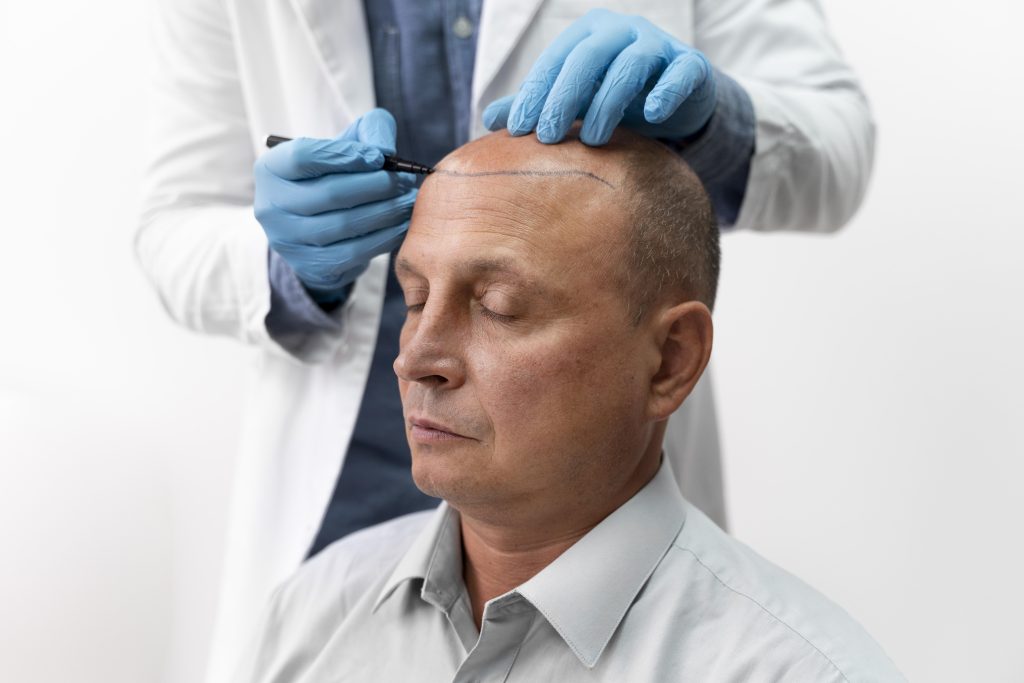Thinking of gaining hair back through surgery sounds scary, right? A hair transplant is a surgical procedure that moves follicles of healthy hair to bald or thinning areas of the scalp. It may seem like a complex surgery, but when performed under the supervision of a trained physician, a hair transplant is a safe and result-driven procedure.
Even if you are familiar with the procedure, it is obvious to stay in two minds. The timeline for recovery and post-surgery protocols typically remains the same for everyone.
Having realistic expectations in mind helps to manage and cope with the recovery and outcome of a hair transplant. Here we’ve outlined most of it – all for you!

What is a hair transplant?
Hair restoration or hair transplantation is for people who have already tried hair loss treatments but haven’t got any good results. Like any medical procedure, a hair transplant occurs in a specialist’s clinic. Chandra clinic is the specialist’s clinic for Hair transplant in Delhi. In this, hair follicles from a donor site are transplanted to the bald areas (patches) of the head. Usually, these follicles are harvested from the back or sides of the head which helps natural hair to grow back.
Dermatologists or plastic surgeons specializing in reconstructive hair transplants perform the surgery.
How does a hair transplant work?
A donor site is used for taking grafts (small pieces of skin) from the head or body that contain healthy hair. Usually, the back of the scalp is the right place to make a graft where hair tends to be thickest. The specialists implant the prepared grafts into the hairless parts of the scalp. Once transplanted, the skin takes time to heal. First hair regrowth will begin 2-3 months after your procedure is performed and will continue to grow hair at its pace.
What conditions does hair restoration surgery treat?
Hair loss is a big concern for everyone. In general, the condition is temporary and can happen due to hormonal imbalances, stress, pregnancy, childbirth, menopause and thyroid problems. For some people, hair loss can become a reason to worry as it can be permanent, which may be caused by:
- Autoimmune disease (Alopecia Areata)
- Pattern baldness (Androgen Alopecia)
- Hereditary issues
- Reaction to radiation therapy
- Reaction to hair treatments
- Medications or supplements
- Traumatic injuries or burns
What can one expect post hair transplantation?
During the immediate stages of hair transplant recovery, there is a possibility that the area remains tender and extremely delicate. For a day or two, you might have to wear bandages over the scalp to ensure that the area is protected. Mild pain can be present for a couple of days after the hair transplant procedure. Some pain-relieving medications are prescribed in this phase.
There will be some bruising and scabbing as the incision sites heal. There is nothing to worry about, as you can return to work 3 to 5 days after the surgery. With FUE hair transplant, the recovery and healing process is manageable.
Recovery:
Of course, the urge to see the natural-looking healthy hair again is irresistible. But the primary concern is how long it takes to recover. Here is what you need to know:
2 to 3 weeks after the surgery:
In this period, the newly transplanted hair will fall out. This is normal and a part of the hair regrowth. The follicle remains healthy and returns to the growth phase within a few weeks.
2 to 3 months after the surgery:
The transplanted hair remains in the resting phase, another typical part of the procedure. Some might find the same outlook as before the surgery. We advise you to continue the postoperative precautions and instructions carefully, along with follow-up visits with a specialist.
4 to 8 months after the surgery:
In between 4 to 6 months, new hair growth from the transplanted follicle may be witnessed. However, new hair growth varies for every patient as the healing time is different. At this stage, new hair growth can be delicate and thin.
8 to 9 months after the surgery:
By the end of the 9th month, achieving longer and thicker hair becomes easy. You can even style your hair. However, a follow-up examination with a specialist is still required.
By the end of the 12th month
In terms of growth, one year is enough to enjoy the result of FUE hair transplant surgery. Most of the follicles give healthy hair. People may require to visit for check-ups as recommended by the specialist.
Risks and Costs of Treatment
As with any kind of surgery, hair transplants may have some risks that can be:
- Slight scarring
- Unnatural-looking hair growth
- Infection or inflammation
- Bleeding
- Shock loss, which is temporary (loss of original hair)
It is important to stay in touch with your specialist to check the improvement, healing and growth of hair after the surgery. If there are some side effects or discomfort after any session of the procedure, seek medical attention immediately.
The price of a hair transplant treatment purely depends on the number of hair grafts required and the method of transplant applied by the surgeon. Also, the cost of the procedure varies based on the clinic you choose for the transplant, their packages, specialist consultation and post-op care facilities. It is hard to say if the insurance companies provide coverage for the treatment.





